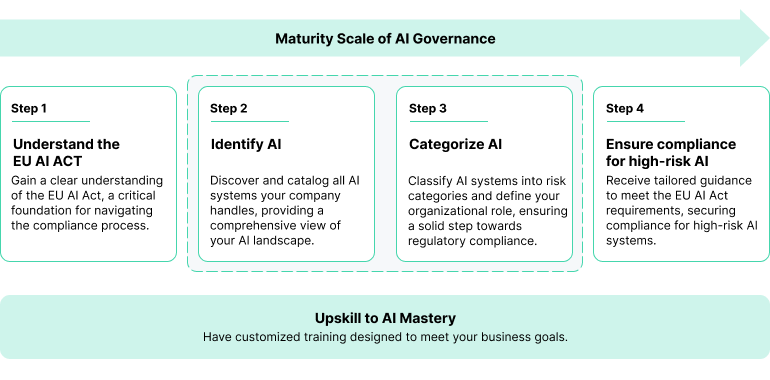By implementing a robust AI governance framework early, businesses aren’t just avoiding fines—they’re building trust, improving AI performance, and positioning themselves as industry leaders.
If your company develops or uses AI, you’ve undoubtedly heard about the EU AI Act and its substantial penalties (up to €35M or 7% of global revenue, whichever is higher). But beyond avoiding fines, there’s a compelling business case for embracing AI governance now. AI governance delivers a competitive advantage through improved operations and innovation. Companies that implement comprehensive AI governance frameworks aren’t just checking compliance boxes—they’re creating sustainable competitive advantages through:
- Enhanced model performance and reliability
- Accelerated AI development cycles
- Increased stakeholder trust and brand value
- Reduced operational risks and technical debt
For proof that responsible AI pays off, Accenture highlights a small group (12%) of high-performing organizations that are using AI to generate 50% more revenue growth while outperforming on customer experience and ESG metrics. On average, these high-performers are 53% more likely than their competitors to be responsible by design (i.e., built on solid data and AI governance principles across the complete lifecycle).
In this first of a series of blog posts about responsible AI, we’ll explore how the EU AI Act’s requirements can serve as a blueprint for building better AI systems and show you how to transform regulatory compliance into market leadership. Intellias will help you define the AI’s role in your organization and ensure you’re staying ahead of emerging regulations, based on our responsible AI practices that turn technology into an enabler.
Understanding the EU AI Act
The EU AI Act classifies AI systems and general-purpose AI models (GPAI) based on their potential impact on people’s lives, safety, and rights, with each level requiring different compliance measures. No matter where your company is based, the rules apply if EU residents use your AI. By viewing these requirements through the lens of AI governance, organizations can build more trustworthy AI systems that stand out in an increasingly crowded market.
Though certain sectors are exempt—AI for research, military, national security, and non-professional purposes—those providing or deploying AI tools in a professional context in the EU must adhere to the new Act.
Based on the risk to citizens’ safety and rights, the Act divides AI systems into four risk levels and GPAI into two. Each risk level carries its own obligations, from outright bans on AI applications with a severe negative impact on safety, health, and human rights to a very light touch on the most benign. This risk-based approach allows for innovation while protecting fundamental rights.
To sum it up
- Effective date: August 1, 2024 (with a three-year rollout)
- Who’s affected: Any company whose AI systems and GPAI are used by EU residents
- Maximum fines: €35M or 7% of global annual revenue (whichever is higher)
- Key exception: Research and development (but only until you go commercial)
Your role in the AI ecosystem
The EU AI Act defines six roles in the AI ecosystem, each with unique opportunities to create competitive advantage through strong governance:
Providers develop AI systems or GPAI and place them on the EU market under their name or trademark, whether for payment or free of charge. Early adopters of comprehensive AI governance frameworks can differentiate themselves as trusted partners, potentially commanding premium pricing and preferred vendor status. Strong governance also helps providers accelerate development cycles and reduce compliance costs across their AI portfolio.
Deployers implement AI developed by other companies in their business. By establishing robust AI governance practices, deployers can better evaluate and integrate AI solutions, reducing operational risks and improving ROI on AI investments. Strong governance frameworks also help deployers quickly adapt to changing regulatory requirements and scale their AI usage more effectively.
Product manufacturers place products with embedded AI systems in the market under their own name or trademark. Through effective AI governance, manufacturers can better manage their AI supply chain, ensure product quality, and build trust with end-users. This translates to stronger brand value and reduced liability risks.
Importers bring AI systems or GPAI developed by non-EU companies into the market. With strong governance practices, importers can better assess potential risks, ensure compliance, and position themselves as trusted intermediaries between non-EU providers and EU customers.
Authorized representatives act as intermediaries between non-EU providers and EU authorities and consumers. By implementing robust governance frameworks, they can offer enhanced compliance assurance services and build stronger relationships with both providers and regulators.
Distributors supply AI to the EU market without taking on other roles. Strong AI governance helps distributors evaluate the AI systems they distribute more effectively, manage compliance documentation more effectively, and build trusted relationships with suppliers and customers.
Many companies wear multiple hats – you might be developing an AI system (Provider) while also using third-party AI tools in your operations (Deployer). In these cases, a comprehensive AI governance framework becomes even more valuable, helping to manage compliance obligations while creating operational efficiencies across roles.
Remember that while providers bear the majority of compliance obligations, every role in the AI ecosystem can leverage strong governance practices to create competitive advantages and build trusted relationships with partners and customers.
The risk categories: A quick look
The Act divides AI systems into four categories based on their potential impact:
Unacceptable risk (the “no-go zone”): Think of social scoring systems or AI that manipulates vulnerable people. These are entirely banned.
High risk (the “proceed with caution” zone): AI systems that could significantly impact people’s lives, such as HR tools that screen resumes or evaluate job performance, medical diagnosis systems, credit scoring systems, and law enforcement AI.
Limited risk (the “transparency” zone): AI systems that interact with end users like customer service chatbots or image generators.
Minimal risk (the “green light” zone): AI applications that don’t have a significant impact on safety, health, or human rights like spam filters, gaming AI, and inventory management systems.
Similarly, the Act differentiates between GPAI and GPAI with systemic risk. The latter are very large state-of-the-art foundation models that can have a significant negative impact if misused.
Our next blog post will explore these risk categories in more depth.
What this means for your business
If you’re developing or using AI that touches EU residents, you need a game plan. While the obligations vary dramatically based on risk category and your role, the EU AI Act compliance benefits can be significant. From simple transparency obligations to comprehensive documentation and monitoring systems, each requirement presents an opportunity to strengthen your AI operations. It’s a BIG job, but one that can transform your business.
Getting compliant
Many organizations need help transforming EU AI Act requirements into business opportunities. Our AI compliance framework provides a strategic roadmap that goes beyond compliance to create lasting competitive advantages.

Step 1 – Understand the EU AI Act as a framework for excellence
The first step goes beyond basic compliance knowledge. Our workshop helps your company understand not just the requirements but how to leverage them to build better AI systems. We’ll show you how leading organizations are using the Act’s requirements to improve AI adoption, enhance documentation, and build stakeholder trust.
Step 2 – Strategic AI inventory
This critical step identifies all AI systems your company develops and uses—from HR’s resume screeners to customer service chatbots and AI-powered product features. We go beyond simple cataloging. Our approach helps you:
- Identify opportunities to improve AI performance
- Spot potential synergies across systems
- Reduce redundant AI investments
- Create a foundation for scaling AI governance across your enterprise
Step 3 – Risk categorization
We help you evaluate risk levels of your AI systems and assess whether your GPAI pose systemic risk. This classification process becomes a strategic tool for:
- Prioritizing governance investments
- Identifying opportunities for competitive differentiation
- Optimizing resource allocation
- Building stakeholder confidence through transparent risk management
Step 4 – Ensure compliance for high-risk AI
For companies developing or deploying high-risk AI, we transform compliance requirements into competitive advantages. Our experts help:
- Analyze current systems against best practices
- Implement governance frameworks that improve AI adoption and build stakeholders’ trust
- Build documentation systems that accelerate development
- Create monitoring processes that reduce operational risks
The Intellias AI governance framework will teach your team the ins and outs of the EU AI Act—not just for compliance of all your current AI but also for all future AI that your company may develop or deploy. Your employees will be ready and able to spot and prevent any potential violations of the EU AI Act before you’re out of the pre-planning stage.
Throughout this process, we can conduct customized AI training to upskill your workforce and meet your business goals.
Time to act: Seizing the AI governance opportunity
The EU AI Act is no longer on the horizon; it’s here. Since its enforcement began in August 2024, companies worldwide have been racing to understand and implement its requirements. While the full implementation extends through 2027, the time for action is now, especially for enterprises with multiple AI systems across different departments.
Strong AI governance frameworks deliver multiple business benefits:
- Accelerated AI development through standardized processes
- Improved model performance via systematic monitoring
- Built deeper trust with customers and stakeholders
- Reduced operational risks and technical debt
- Created sustainable competitive advantages in their markets
The window for gaining a first-mover advantage is closing quickly. Properly completing a thorough AI inventory, system categorization, and governance implementation takes months. Add the time needed for documentation, system optimization, and team training, and you’ll understand why market leaders are already deep into their governance journeys.
The good news? You don’t have to navigate this transformation alone. Having a knowledgeable partner can mean the difference between checking compliance boxes and creating lasting competitive advantages.
In our next blog post, we’ll dissect each risk category and its meaning for your specific AI applications. Until then, take that crucial first step: start documenting your AI footprint. With the Act already in force, every day of delay increases your compliance risk.
Ready to begin your journey toward AI governance excellence? Let’s talk about how we can help you become a leader in responsible AI innovation.


